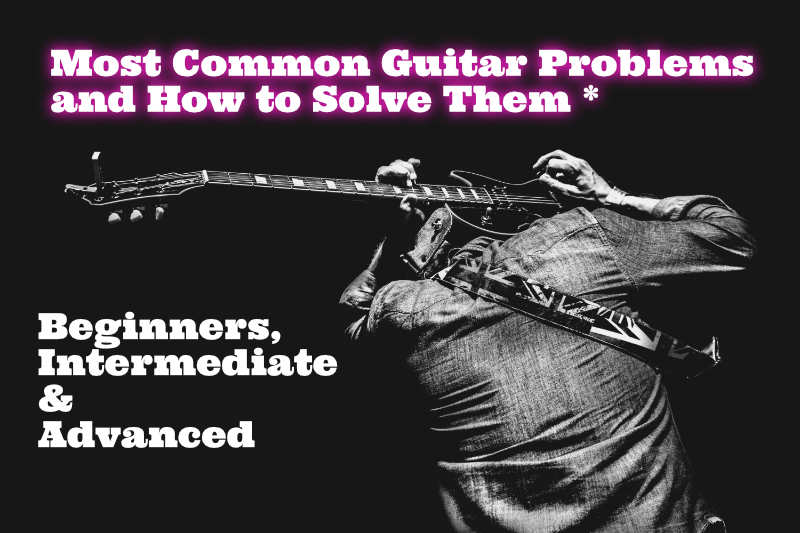October 6, 2024 by Klaus Crow

No matter where you are on your guitar-playing journey, whether you’re just learning your first chords, refining your technique, or exploring complex improvisation—every guitarist faces their fair share of obstacles. From struggling with hand coordination as a beginner to breaking through plateaus as an advanced player, each level of experience brings its own unique challenges.
Sometimes, It seems like your problems are insurmountable and your progress is leading nowhere, but with the right directions and solid practice you will get there definitely.
In this post, we’ll dive into the most common guitar problems at every stage of your playing and offer practical solutions to help you overcome them and keep progressing.
Beginner Guitar Problems and Solutions

1. Sore Fingers
Problem: Beginners often experience sore fingertips, especially when they first start pressing down on the strings. This Is totally natural and it’s part of building calluses on your fingertips, but it can be quite annoying.
Solution: Start by practicing in shorter sessions, gradually increasing your playing time as your fingers adjust. If the pain is too much, take a break, but stick with it. After one or two weeks of consistent practice, your fingertips will toughen up and the annoying feeling will diminish and eventually disappear.
2. Struggling with Chord Transitions
Problem: Switching between chords can be frustrating for beginners, especially when trying to keep up with a song’s rhythm.
Solution: First focus on practicing and memorizing your chords diligently, then practice slow, deliberate transitions between two chords at a time. Visualize, have a clear picture in your mind of where every finger is on the next chord.
Focus on minimizing unnecessary finger movement, Try to keep your fingers movement at a minimum. Keep your fingers as close to the strings as possible when you’re changing chords. Gradually speed up as you become more comfortable, and incorporate easy songs that use the chords you’re practicing to build confidence. Apply all techniques to enhance your chord transitions.
3. Difficulty with Strumming Patterns
Problem: Strumming patterns can be confusing for beginners, especially when trying to stay in rhythm with the music.
Solution: Start by mastering a simple downstroke strum, playing along to a metronome, a strumming pattern video lesson or tapping your foot to the beat. Once comfortable, introduce more basic strumming patterns. Listen carefully to songs and try to mimic the rhythm and break down the strumming patterns.
4. Muted or Buzzing Strings
Problem: Beginners often struggle with buzzing or muted strings when pressing down on the frets.
Solution: This issue is usually caused by improper finger placement. Make sure your fingers are pressing down just behind the fret (not directly on it) and apply enough pressure. Check your hand position to ensure your fingers aren’t accidentally touching other strings. Practice scales or simple chords slowly to improve your finger accuracy and strength.
Strings that are old, worn out, or dirty can also lead to muted or buzzing sounds and finally If the action (the distance between the strings and fretboard) is too low, the strings may buzz against the frets when played. Let your local guitar luthier check out your guitar.
5. Implementing the Habit of a Regular Guitar Practice
Problem: Implementing the habit of a regular guitar practice into your busy daily life can be quite a challenge.
Solution: Begin with just 10-15 minutes of practice each day. As you get used to practicing, gradually increase the time. Find a time that works well for you, whether it’s in the morning, after work, or before bed. Set a reminder or calendar alert to prompt you.
Having a designated spot for practicing reduces the resistance to starting and minimizes distractions. Rather than just practicing aimlessly, set small, achievable goals like learning a new chord, mastering a strumming pattern, or playing a specific song. Breaking larger goals into smaller tasks makes it more manageable. Be patient, building a habit takes time, and consistency is more important than immediate results.
Intermediate Guitar Problems and Solutions

1. Struggling with Barre Chords
Problem: Barre chords, like F and B minor, can be challenging for intermediate players due to the need for finger strength and proper positioning. Many players struggle with buzzing strings or incomplete chords.
Solution: Strengthen your fingers by practicing bar chord finger exercises and playing songs with bar chords. Start with partial barres (covering only a few strings) and gradually work up to full six-string barres. Proper technique is crucial, so position your thumb behind the neck for better leverage and keep your index finger straight to press down the strings cleanly.
2. Inconsistent Timing and Rhythm
Problem: Timing can be tricky, especially when playing more complex strumming or picking patterns. Some players may speed up or slow down without even noticing it, disrupting the flow of the song.
Solution: Use a metronome to practice staying on beat. Start slowly and increase the tempo as your timing improves. Break down complex patterns into smaller, manageable parts, and work on them individually before piecing them together. Tapping your foot or nodding along to the beat can also help solidify your rhythm. Find a guitar buddy who is good at rhythm guitar and jam together, observe and learn.
3. Speed and Accuracy
Problem: Playing faster passages cleanly can be tough, often resulting in sloppy playing, missed notes, or muted strings.
Solution: Practice difficult sections slowly at first to build muscle memory and ensure accuracy. Gradually increase your speed using a metronome. Focus on finger placement, keep your movements small and close to the fretboard to improve speed.
When you try to play faster your fingers probably get more tense. Tension reduces speed so try to loosen up while your playing. Analyze your playing. Take notes from your observations. Study your left and right hand. Where do you come short? How can you fix it? Think creative and come up with exercises or solutions to improve your obstacle. Practicing regularly gets better results.
4. Weak Bends and Vibrato
Problem: Achieving strong, controlled bends and vibrato can be tough for intermediate players.
Solution: Start with a slow vibrato. Focus on moving the string smoothly up and down without rushing. Once you’ve mastered slow vibrato, gradually increase the speed while keeping the motion fluid. Proper vibrato should come from the wrist and forearm, not just finger movements.
Place your thumb behind the neck or on the side of the neck for leverage. This allows you to pull or push the string more effectively while keeping your hand stable. Study the vibrato of famous guitarists like B.B. King, Eric Clapton, or David Gilmour. Try to emulate their style and feel, and see how they use vibrato to enhance their phrasing
5. Struggling with Improvisation
Problem: Many intermediate players feel stuck when improvising, relying too heavily on scales without creating musical or interesting phrases.
Solution: Learn specific licks and phrases in different keys to incorporate into your solos. Think of improvisation as creating a melody rather than running through scales. Work on your ear training to better recognize the relationship between notes, and practice improvising over backing tracks or with other musicians to improve your phrasing and timing.
Practicing, transcribing and learning from famous guitar solos is essential to learn the language of soloing and gain inspiration and insight to craft your own. Study the phrasing of great guitar players. Keep at it, keep creating melody from scales and patterns, incorporating licks, learning from solos, studying other guitar players, practice, practice and practice some more. You’ll get there.
Advanced Guitar Problems and Solutions

1. Difficultly soloing by ear
Problem: Advanced players may find it challenging to improvise solos by ear, struggling to translate what they hear in their heads into actual notes on the guitar, resulting in frustration and a lack of creativity.
Solution: Start by developing your ear with targeted ear training exercises. Use apps or online resources that focus on interval recognition, chord progressions, and melody dictation. Begin with simple melodies from songs you know well, and try to play them back on your guitar without looking at sheet music or tabs. Record yourself improvising over backing tracks, paying attention to what sounds good and what doesn’t. Gradually increase the complexity of the songs or improvisations you work on. Additionally, practice playing along with recordings of your favorite guitarists, trying to mimic their solos and phrasing to build a stronger connection between what you hear and what you play.
2. Complex Rhythms and Odd Time Signatures
Problem: Advanced players often struggle with complex rhythms, syncopation, or playing in odd time signatures like 7/8 or 5/4.
Solution: Break down the rhythm into smaller segments to understand its structure. Use a metronome to practice at a slow tempo, focusing on hitting the beats accurately. Clap out the rhythm first to internalize it before playing on the guitar. Watch Youtube drum video lessons on how to count complex time signatures. Additionally, practice playing along with songs that feature odd time signatures to develop your feel for these rhythms.
3. Overusing Scales and Patterns in Solos
Problem: Advanced players may rely too heavily on scales or predefined patterns when soloing, resulting in predictability and a lack of originality.
Solution: Break out of the scale mindset by incorporating arpeggios, chromatic notes, or interval-based playing into your solos. Practice targeting chord tones when improvising, focusing on the notes that belong to the underlying chords in the progression. Challenge yourself to play solos that don’t strictly follow scale patterns by focusing on phrasing and emotion instead. Use backing tracks in different styles and push yourself to improvise without thinking about scales, letting your ear guide your playing.
4. Learning to Play Jazz Improvisation
Problem: Many advanced guitarists struggle with jazz improvisation due to the complex harmonies, intricate chord progressions, and the improvisational nature of the genre, often feeling overwhelmed or unsure where to begin.
Solution: Start by familiarizing yourself with basic jazz theory, including understanding seventh chords, extensions (9ths, 11ths, 13ths), and common chord progressions like ii-V-I. Learn to play scales that are essential for jazz, such as the major, minor, and diminished scales, along with the modes of the major scale. Practice playing along with jazz standards using backing tracks to develop your ear and understanding of the style.
Focus on creating short motifs and building your solos around them, allowing for variations as you go. Analyze and transcribe solos from iconic jazz guitarists, such as Wes Montgomery or Joe Pass, to understand their phrasing and melodic choices. Finally, don’t forget to jam with other musicians, as improvisation is often a collaborative effort in jazz, helping you to think on your feet and adapt to different musical ideas.
5. Feeling Stuck in a Playing Rut
Problem: Advanced players may experience periods of stagnation in their playing, feeling uninspired, stuck in repetitive patterns and a lack of motivation.
Solution: Challenge yourself by learning a new genre or style that you typically don’t play. This can introduce new techniques and concepts to your playing. Take lessons or watch tutorials to gain fresh insights and approaches. Set specific goals for your practice sessions, such as learning a challenging piece or mastering a new technique, to keep your playing focused and productive. Collaborate with other musicians to gain new perspectives and inspiration. Learn how to write and record a song. Set an audacious guitar goal for yourself.
Ask yourself the following questions: What do I enjoy most about playing the guitar? What new techniques or songs do I want to learn? How could I make guitar playing really fun again? What would be the ultimate goal in my guitar / music journey? By asking yourself these questions and reflecting on the answers, you can find renewed inspiration and motivation.
Leave a Reply